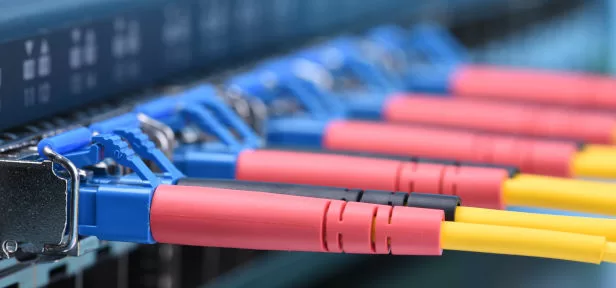Swiss telecom service providers Sunrise and Salt entered into a strategic partnership to build an optical fiber network. A new company, Swiss Open Fiber, has been jointly established by the two telecom service providers for this purpose.
1. Why would Sunrise and Salt build optical fiber networks?
Currently, around one-third of Swiss households have access to optical fiber connections. Swiss Open Fiber aims to connect an additional one-third of households to optical fiber.
The regions being targeted are those which are not currently serviced by optical fiber networks from Swisscom or local power companies. Suburban regions are the primary target of the new collaboration.
Sunrise and Salt cite the lack of country-wide infrastructure as a hindrance to their offering their products to a broader audience. They have also criticized the planned optical fiber network expansion by market leader Swisscom as a further strengthening of its “monopoly” status.
“Putting pressure on Swisscom is part of the reason Sunrise and Salt have formed this collaboration,” says Ralf Beyeler of moneyland.ch.
2. What does the new competition mean for Swisscom?
The move puts pressure on Swisscom.
Swisscom has largely neglected the expansion of its optical fiber network in recent years. Swisscom has primarily expanded its network in regions where municipalities or power companies already stated an interest in building their own optical fiber networks.
In these cases, Swisscom has typically entered into partnerships with municipalities or power companies to build modern optical fiber networks. This was the case in the cities of Basel, Bern and Zurich.
Recently, Swisscom announced that it planned to expand its optical fiber network. A number of Swisscom’s competitors criticized Swisscom’s technological plans as anticompetitive.
It is very possible that forcing Swisscom to rethink its strategy was one of the factors behind the establishment of the join Swiss Open Fiber project.
“Over the mid-term, we may see Swisscom collaborate with Swiss Open Fiber to jointly develop Switzerland’s optical fiber network,” muses Ralf Beyeler. Such a collaboration would speed up the process of connecting households to optical fiber.
3. How long will it take Swiss Open Fiber to build a network?
The construction of the network is expected to take between five and seven years. The goal of Swiss Open Fiber is to connect 1.5 million Swiss household to optical fiber by the year 2027.
4. Can other telecom service providers use the Swiss Open Fiber network?
Yes. Swiss Open Fiber is an open network. Other telecom service providers can make use of the Sunrise/Salt network to provide their own services.
3. Which cantons have the best networks?
There are major differences in optical fiber network coverage between cantons. The canton of Basel-Stadt has the strongest coverage. According to Swiss Open Fiber, 84% of households in Basel-Stadt are equipped with optical fiber connections.
Other cantons which have strong optical fiber networks are Appenzell-Ausserrhoden (74%), Nidwalden (57%) and Valais (53%). Cantons which are not broadly covered by optical fiber networks include Neuchâtel (1%), Glarus (2%), Jura (4%) and Uri (4%). Even the cantons of Zurich (33%), Geneva (29%), Vaud (34%) and Aargau (10%) have relatively low network coverage.
4. Will the same households be connected to multiple optical fiber networks?
Sunrise and Salt have stated that they aim to build networks in areas which are not already serviced by existing optical fiber network. Swisscom has also recently announced an expansion of its optical fiber network.
“There is little sense in Swisscom and the Sunrise-Salt alliance building separate optical fiber networks,” observes Ralf Beyeler. “In many regions, it would be more logical for Swisscom, Sunrise and Salt to jointly build optical fiber networks together.”
In Switzerland, the standard practice is to use the four-cable model. In this model, a single optical fiber network operates in any one region. Each connection to the network is comprised of four separate optical fiber cables, with one cable reserved for Swisscom and a second typically reserved for a local power company. The remaining two cables can be purchased by other companies. This model would technically allow Salt, Sunrise and Swisscom to use one connection each, with the fourth connection being available to local power companies or municipalities.
5. Does Salt Open Fiber benefit consumers?
Once the network is up and running, two-thirds of Swiss households will have access to optical fiber networks. That means double the number of households will have fast and stable access to the Internet via optical fiber. Consumers will be able to choose from a larger number of broadband Internet plans.
Currently, consumers in many regions can only get high-speed Internet connections from local cable network operators like UPC or Quickline. Other telecom service providers are generally limited to offering primarily low-speed Internet connections via Swisscom’s telephone line network. As new optical fiber networks are laid, telecom service providers will also be able to offer high-speed Internet connections.
6. Will the optical fiber expansion result in lower telecom prices?
Building a new optical fiber network is very expensive. The cost of connecting 1.5 million households to the Swiss Open Fiber network is estimated at up to 3 billion Swiss francs.
With those overheads, it is unlikely that the new network will bring prices down. However, the new network will make a much broader array of broadband Internet plans available to telecom users in Switzerland. A number of very affordable optical fiber telecom plans are already available, but these can only be used by households which have optical fiber connections.
The optical fiber expansion will put pressure on cable network operators like UPC to lower their prices – which at the moment are relatively high. UPC is currently able to put high price tags on its Internet plans because in many regions, it is the sole provider of high-speed Internet.
More on this topic:
Compare Swiss Internet plans now
Broadband technologies compared



